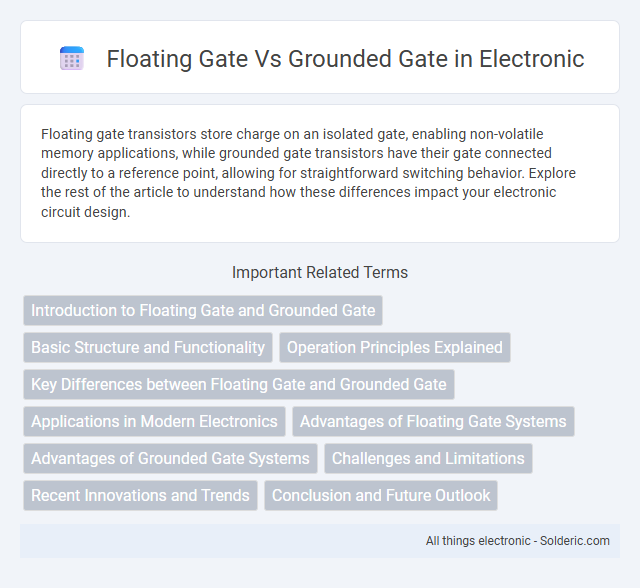Floating gate transistors store charge on an isolated gate, enabling non-volatile memory applications, while grounded gate transistors have their gate connected directly to a reference point, allowing for straightforward switching behavior. Explore the rest of the article to understand how these differences impact your electronic circuit design.
Comparison Table
| Feature | Floating Gate | Grounded Gate |
|---|---|---|
| Definition | Gate electrically isolated with no direct connection to voltage source. | Gate connected directly to a reference ground or fixed potential. |
| Charge Storage | Can store charge, enabling non-volatile memory functionality. | No charge storage capability; gate voltage fixed by ground. |
| Applications | Used in EEPROMs, flash memory, and programmable devices. | Common in standard MOSFET and transistor switching circuits. |
| Control | Electric field controlled by trapped charge affects device behavior. | Gate voltage controlled directly via grounded reference. |
| Complexity | More complex manufacturing due to charge isolation layers. | Simpler design with direct gate-to-ground connection. |
| Data Retention | Excellent data retention without power supply. | No data retention; state lost when power off. |
Introduction to Floating Gate and Grounded Gate
Floating gate transistors feature an electrically isolated gate that stores charge to retain information in non-volatile memory, enabling long-term data storage without power. Grounded gate transistors have their gate terminal connected to ground, providing stable reference potential and primarily used in analog and digital switching applications. Understanding the differences between floating gate and grounded gate configurations is crucial for designing memory cells or logic circuits aligned with your device's performance requirements.
Basic Structure and Functionality
Floating gate transistors feature a gate completely isolated by an insulating layer, enabling charge storage that retains data without power, crucial for non-volatile memory like EEPROM and Flash. Grounded gate transistors have their gate directly connected to the ground, allowing immediate control of the channel conductivity without storing charge, commonly used in basic switching applications. This fundamental structural difference determines their function: floating gates modulate threshold voltage through trapped charge, while grounded gates rely on direct voltage control.
Operation Principles Explained
Floating gate transistors operate by trapping charge on an isolated gate electrode, enabling non-volatile memory storage through changes in threshold voltage. Grounded gate transistors have their gate connected directly to a reference potential, allowing immediate control of the channel without charge retention. Understanding these operation principles helps optimize your electronic circuit designs for memory retention or switching applications.
Key Differences between Floating Gate and Grounded Gate
Floating gate transistors have a conductive gate isolated by an oxide layer, enabling charge storage and non-volatile memory functionality, while grounded gate transistors have their gate connected to the ground, resulting in standard transistor switching behavior without charge retention. The floating gate's ability to trap electrons allows programmable threshold voltage, making it essential in EEPROM and flash memory, whereas grounded gate devices do not exhibit this characteristic. Structurally, floating gate devices require precise insulating layers to prevent leakage, contrasting with the straightforward conduction path of grounded gate transistors.
Applications in Modern Electronics
Floating gate transistors are predominantly used in non-volatile memory devices such as EEPROMs and Flash memory, where charge storage enables data retention without power. Grounded gate transistors are commonly applied in standard digital logic circuits, amplifiers, and switching devices, providing stable control of current flow. Your choice between these gate types impacts memory retention capabilities and circuit design efficiency in modern electronics.
Advantages of Floating Gate Systems
Floating gate systems offer superior data retention and higher noise immunity compared to grounded gate configurations, making them essential in non-volatile memory devices like EEPROM and Flash memory. Their ability to store charge without a continuous power supply enhances durability and reliability for long-term data storage. You benefit from improved performance in memory applications due to the floating gate's efficient charge trapping and isolation properties.
Advantages of Grounded Gate Systems
Grounded gate systems offer improved stability and reduced noise interference compared to floating gate designs, making them ideal for precise analog and digital circuit applications. Your circuits benefit from enhanced reliability due to the direct reference to ground potential, minimizing unwanted charge accumulation and leakage issues. This results in better performance and longevity, especially in environments with fluctuating electrical conditions.
Challenges and Limitations
Floating gate transistors face challenges including charge retention issues and susceptibility to interference from background radiation, which can degrade data integrity over time. Grounded gate devices, while more stable in terms of charge control, suffer from increased leakage currents and reduced scalability in advanced semiconductor processes. Understanding these limitations helps tailor Your design choices for memory applications requiring reliability versus durability.
Recent Innovations and Trends
Recent innovations in floating gate technology emphasize enhanced charge retention and reduced interference, crucial for non-volatile memory advancements like NAND flash. Grounded gate devices benefit from emerging materials such as high-k dielectrics and two-dimensional semiconductors, improving transistor scaling and energy efficiency in next-generation integrated circuits. Trends indicate a growing integration of floating gate structures with advanced error-correcting codes and adaptive programming algorithms to address scaling challenges.
Conclusion and Future Outlook
Floating gate technology remains pivotal in non-volatile memory devices due to its high charge retention and scalability, while grounded gate structures enhance transistor performance by reducing leakage currents and improving switching speeds. Emerging innovations combine these concepts to optimize memory density and energy efficiency in advanced semiconductor applications. Future developments will likely focus on integrating floating gate elements with novel materials and low-power architectures to meet the growing demands of AI and IoT technologies.
Floating gate vs Grounded gate Infographic

 solderic.com
solderic.com